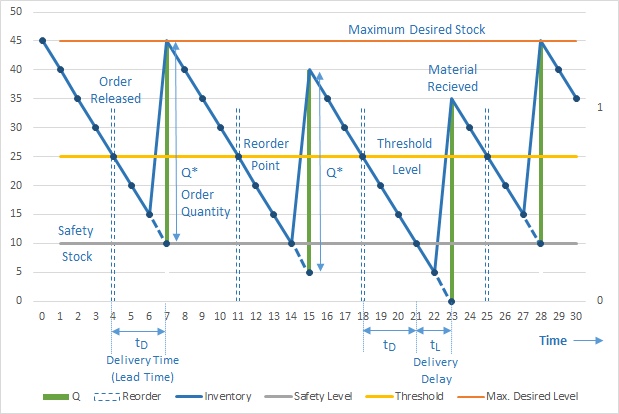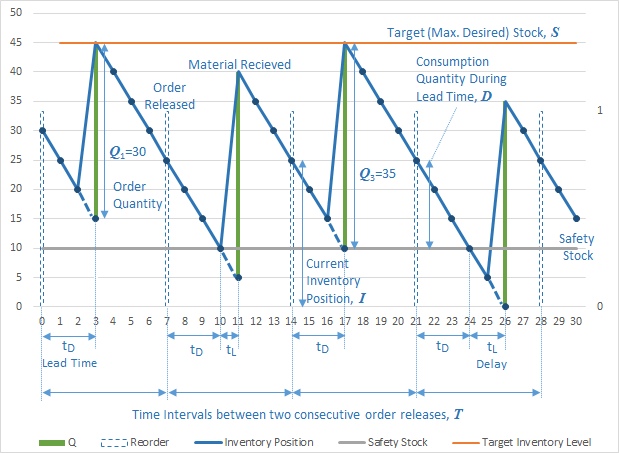17:23 Inventory Policies | |||||||||||||||||||||||||||||||||||||||||||||||||||||||||||||||||||||
|
Inventory Policies(c) Kravchenko Volodymyr
What Is Inventory?Inventory (stock) – materials in a supply chain or in a segment of a supply chain, expressed in quantities, locations and/or values, not used at present, but kept for the future use, consumption or sale (Krzyżaniak, 2009). Widely adopted stock classification is as follows:
Next stock types are classified by the reasons for keeping:
One more classification by rotation
Inventory Control Issues
VariablesTo describe the inventory movement there are two variables:
Changing the volume of a stock for a certain time is the main issue for ensuring needs in materials or products to be solved for a storage location. Managers have to support the material stocks at certain storage location to satisfy the consumption for a given (target) level in despite of the peculiarities of replenishment and consumption. Not being able to directly influence the parameters of needs in materials (products), managers apply leverages on supply in accordance with the objectives of inventory control.
Main IssuesThere are two main issues in inventory control
Both issues are interrelated. Based on the replenishment size, which is needed to meet the desired or predicted (planned) needs, managers can determine when orders must be issued. To change the inventory volume managers have only two tools:
Continuous and Periodic Inventory ReviewFor inventory (supply, replenishment) planning horizon we are mainly using two major classes of inventory policies
Continuous inventory review, also known as perpetual review, involves a system that tracks each item and updates inventory counts each time an item is removed from inventory. For example, a retailer may use bar code scanners to record customer purchases and update inventory counts every time a cashier scans a product code. Continuous inventory review permits real-time updates of inventory volume. It makes easier to set time and volume to inventory replenishment. This review also facilitates accurate accounting, and the inventory system generates real-time costs of goods sold. The main disadvantage of this class of inventory policy consists in the cost of implementation. Bar code scanners, inventory software and computer systems are needed for continuous inventory review (Pearson). Periodic inventory review involves counting and documenting inventory at specified times. For example, a retail store operating under a periodic review policy might count inventory at the end of each month. Periodic inventory review reduces the time managers spend analyzing inventory counts. It allows devoting more time for other aspects of running the business. This review is helpful when the monitoring of stocks is manual, or the number of items involved is extremely large, or when constraints on ordering-day exist. However, it may not provide accurate inventory counts for businesses with high-volume sales. Managers must make assumptions between inventory review periods regarding inventory counts. This can make it difficult to ascertain when items are to be reordered. It also can make accounting less accurate (Pearson).
How much is Q?The answer to the question about how much to order can also be based on two criteria. The ordered quantity is either
The level S is often called Target Inventory Level or Order-Up-To Inventory Level or Base Stock Level. All huge variety of other strategies in the inventory control is based on discussed above inventory reviews with a fixed size of an order or a fixed interval of time between orders. The main assumption in the classical inventory reviews is constancy or averaging demand size for a product stock per unit time. However, the demanded amount of stock usually changes over time. Practice of inventory management is focused on rapid decision making with the applying flexible tools.
(s, Q) Inventory PolicyFor the continuous review, primarily we are talking about the (s, Q)-policy (or it is also called perpetual system or a fixed-order-quantity system or two-bin system). It has two parameters – reorder point (s), and order quantity (Q). This policy is often marked by (R, Q) due to s is a reorder point (replenishment point, threshold) that is the predetermined level for inventory position, below which a shortage (stockout) is more likely. The policy content is as follows. Manager order the amount Q if the inventory position is less than this trigger level s. How much is Q? When we assume that demand variability is relatively stable, remember the coefficient of variation for XYZ analysis, we get desired order quantity Q* equal or close to the economic order quantity (EOQ). It does not mean the value of EOQ will be final, but it is thing to begin with. At first, we can make the order size Q* constant and it will not be changing under a little unstable conditions for stocks dynamics. Now, how does manager set s? Manager is tracking demand and inventory position. If inventory position reaches or drops below this threshold (s), manager is going to order Q*. So, managers places an order while he/she is continuously monitoring the inventory position. Figure 1 illustrates the dynamics of inventory amount under (s, Q)-policy.
Figure 1. Inventory Dynamics under (s, Q) Policy
All parameters of this inventory policy are calculated so that in compliance with initial data the policy would guarantee deficit-free satisfying requirements for material (goods) under certainty, i.e. under steady demand, constant rate of consumption. We calculate such parameters of (s, Q)-policy, as:
Maximum desired stock, unlike next two basic parameters has no direct impact on the inventory dynamics. This stock level is set to track how appropriately a storage area is utilized within a warehouse and how much it contributes into total cost. The threshold level (reorder point) is the inventory quantity, which triggers an order to replenish inventory stock. Replenishment requests manufacturing or purchasing and delivery and/or cargo relocation. The size of threshold is calculated so that ordered material (product) will have arrived at a warehouse in the right quantity by the time the inventory stock will decline to the safety stock level. Calculating the threshold, we ignore delivery delay. Safety stock level is the inventory quantity to provide the needs in material (product) for anticipated delivery delay. By the way, we take the maximum value of possible delay. If a company used safety stock up, future supplies would replenish it. Table 1 explains how to calculate the parameters for (s, Q) inventory policy.
Table 1 (s, Q) Inventory Policy: The Procedure for Calculating Parameters
Fix Time Period SystemThe second inventory policy is determined by a system called a fixed-time-period system shown in Figure 2.
Figure 2. Inventory Dynamics under Fixed-Time-Period System
This system checks inventory levels in predetermined time intervals labeled as T. At the expiration of every interval T, at a moment t when inventory position (I) is checked, the order quantity (Q) can be
(t, S) Inventory PolicyYou can meet (t, Q) and (t, S) policies labeled as (R,Q) and (R,S), where R is time interval, the same as T. The (t, S) policy has a target inventory level managers want to maintain. Then, an order (j) is placed every time intervals T to restore the inventory level back to S. This quantity Qj is the difference between the target inventory S and how much inventory is in stock – the I at time (Sanders, 2014: Definitive Guide to Manufacturing and Service Operations, The: Master the Strategies and Tactics for Planning, Organizing, and Managing How Products and Services Are Produced Qj,τ = S – Iτ for τ=t, t+T, t+2T, ... where: Qj,τ – the quantity of j-th order placed at time τ when the interval T is expired S – a target inventory level (an order-up-to inventory level) I τ – an inventory position at time τ when j-th order is placed.
There is another formula for Q Qj,τ = S – ILj,τ+ Dj – Zj,τ where: ILj,τ – an inventory level. Dj – expected demand during lead time for order j Zj,τ – the amount of product in transit, which was not received before the time τ when order j is placed; pipeline inventory. Looking at two equations above, you have noticed for sure Inventory Position = Inventory Level + Pipeline Inventory or I = IL + Z The parameters are determined in order to guarantee deficit-free service of customers or consumers, in other words – to avoid stockout. A target or order-up-to inventory level, S, simply indicates the amount of inventory required to meet all demand. Managers want to have this amount before starting to deal with demand over a forthcoming cycle. As shown in Figure 2 it equals to the sum of safety stock, s, and demand over period between reorders, d: S = s + d Then Q = s + d – IL – Z Table 2 explains how to calculate the parameters for (t, S) inventory policy.
Table 2 (t, S) Inventory Policy: The Procedure for Calculating Parameters
If demand varies slightly, the inventory policy allows avoiding stockouts. Otherwise, there will be shortages when demand will fluctuate. References
| |||||||||||||||||||||||||||||||||||||||||||||||||||||||||||||||||||||
|
|
Главная » 2016 Январь 11 » Inventory Policies


